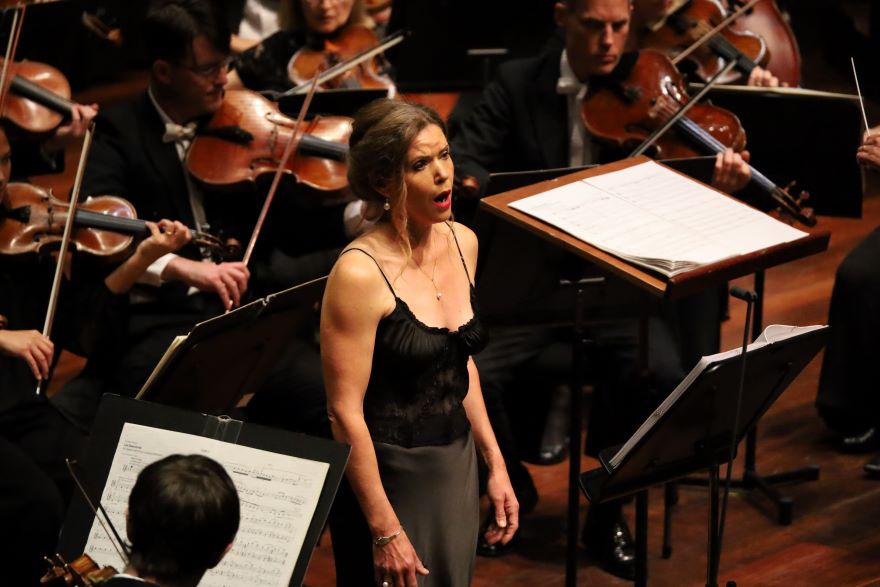Remarkable performances by soprano Sara Macliver and conductor Dane Lam light up this concert by the WA Symphony Orchestra, reports Sandra Bowdler.
Musical fireworks
8 November 2021
- Reading time • 5 minutesMusic
More like this
- Rewriting tradition with skill and charm
- Close encounter stirs the soul
- The great unknown
“Landscape and Wonder”, WA Symphony Orchestra ·
Perth Concert Hall, 5 November 2021 ·
Remember, remember, the fifth of November
Gunpowder treason and plot …
It may have been serendipitous that, on the fifth of November (Guy Fawkes Night) fireworks of different kinds livened up the West Australian Symphony Orchestra’s “Landscape and Wonder” concert.
The opener was Prokofiev’s ever-popular Symphony No. 1, called by the composer the “Classical”. Premiered in 1917, four years after that touchstone of modernism Stravinsky’s Le sacre du printemps, Prokofiev harks back to the classical period to provide a standard framework for his symphony, Allegro-Larghetto-Gavotte-Finale, filling it with modernist touches, such as dissonances and unexpected key changes.
This lively and accessible work is well served by the exuberant conducting of Dane Lam, conductor of the Xi’an Symphony Orchestra and Associate Music Director and Resident Conductor of Opera Queensland. His super brisk opening gave notice that we were in for a delightful ride, thereafter slowing down for a more lyrical reading. After maintaining a light touch in the famous Larghetto (which pops up again in Prokofiev’s ballet Romeo and Juliet), we were off to a racing finish with a sparkling Molto vivace (very much lively) Finale.
Sibelius’s Symphony No 5 was described in the program as one of his most “shining, life-affirming creations”, which it is, compared to its predecessor, the Symphony No 4. Compared to the Prokofiev however it is a lot less successful in pouring new wine into old bottles, in this case an even more formal structure of Tempo molto moderato – Andante mosso – Allegro molto. Each of these movements contains an assortment of short sub-movements, many of them providing opportunities for, variously, strings, woodwinds, brass, and percussion. The second movement can become quite murky, as if the whole thing is about to descend into some messy chaos, but tonight it is saved by the clearly articulated playing of the orchestra. The ending is full of fiery bombast, extremely well-played by orchestra and conductor.

In between these examples of early modernism is interpolated Golijov’s Three Songs for Soprano and Orchestra, composed less than twenty years ago, which could, given the juxtaposition of some very different formal and cultural elements, be described as post-modern. Originally written for American soprano Dawn Upshaw, we were graced with the similarly pure and radiant voice of Sara Macliver.
Looking at the texts on the printed page hardly prepared one for the complexity of the compositions, particularly the first song “Night of the flying horses”, which segues into two whole orchestral movements following the sung words. The Yiddish lyrics have a lullaby feel reminiscent of Gershwin’s “Summertime”. The first two verses are sung a capella, then the voice is joined by strings played pizzicato, with the singing followed by orchestration featuring flutes and clarinets reminiscent of klezmer music, culminating in a wild gypsy dance.
“Lúa Descolorido” owes more to the world of Hispanic music, the lyrics being in Gallego, from Galicia in Spain, the singer immersed in sadness and the music being quietly rhythmic. “How slow the wind”, a setting of two short poems by Emily Dickinson, is also a song of gentle rhythmic sadness with much percussion that rumbles along beneath the floating voice of the soprano.
While this might seem far from Macliver’s usual fare, like much contemporary music it calls for what might be thought of as Baroque technique, rather than (for instance) the over the top vocalism of romantic opera. The judicious use of vibrato and disciplined control of long-breathed phrases are all in abundant evidence. These songs also display the sheer gorgeousness of Macliver’s upper range, and the richness of the middle-low part of her voice. Yes, they were written for someone else, but they could just as easily have been written for Sara Macliver.
Pictured top: Dane Lam conducts the WA Symphony Orchestra. Photo supplied
Like what you're reading? Support Seesaw.






